#any potato in any dish
Explore tagged Tumblr posts
Text
ngl without any shame potatoes are my absolute favourite food. i can eat them any time, any place, any form. i'll cook them everyday, all year. i'll invent new recipes, just to enjoy them in even more versions. i'll consume them until im sick. i'll eat potatoes until i become one.
#potatoes#french fries#baked potatoes#mashed potatoes#boiled potatoes#any potato in any dish#just. potatoes#okay but real talk for a moment#while i stand by what im saying i won't lie my true favourite foods are chicken curry amd rice#and stuffed peppers#also giouverlakia (it's greek)#but i can't eat them ALL DAY EVERY DAY#not like i can with potatoes#skill issue
12 notes
·
View notes
Text
It’s almost midnight
I’m hungry
I want a baked potato
All I want is a baked potato
Everything else looks yucky
I have no potatoes
I’m not eepy
I cannot eep off the humgry
This is the end
I fear I shall perish
#I would settle for any other potato dish too#but the dish isn’t the problem#the lack of potato is the problem#I’ve also only had a few bites of food today—so I crave to potato…I’m gonna blame it on the irish in me#yapping fr#y’all pls ignore me T^T
8 notes
·
View notes
Text
Deruny (Деруни)
I thought it'd be fun to give the recipes for any of the food they mention in the series, so here's the first! Deruny aka Ukrainian Potato Pancakes! I've made something similar myself as it's a basic recipe, so I can fully recommend making these (even though I haven't specifically made Deruny before).
Ingredients:
About 1lb of potatoes (I've always used non waxy for potato pancakes)
1 onion
1 Egg
3 Tbsp of flour
1 Tbsp of sour cream (I use greek yogurt)
Salt and pepper to taste (I don't add salt to mine until after but that's me)
Frying oil (I like peanut as it's pretty flavor neutral and good for high heat. Avocado oil is another good high heat oil if you're making these peanut free. That said I've used canola and even olive in a pinch though I don't really like either of those for frying foods.)
Grate the potatoes and onion into a bowl so you get a nice pile of potato onion mush. I would alternate grating a potato and then some onion until you run out of both because the potatoes will blacken with air exposure, but the onion stops that.
Then add all the other ingredients, except the oil, and mix together. You should have something slightly gloopier and definitely lumpier then actual pancake batter, kinda like thick applesauce.
Heat a few tbsps of oil in your pan and get it fry hot. To check if the pan is ready give it a couple of minutes and you should see the oil start to waver on the bottom of the pan. When you flick some room temp water at the oil surface it should immediately hiss/spit. It's ready.
Take a large spoon or small measuring cup and pour batter into the hot pan so you have a few small roughly 3-4 inch circles in the pan. Fry until golden brown, like 2ish minutes and then flip and do the same to the other side.
Serve these suckers hot! They go well with sour cream, yogurt, hot sauce, applesauce; Quite frankly whatever you like with your potatoes goes with this dish!
Enjoy!
#sherlock & co#sherlock and co#podcasts#recipe#deruny#Деруни#ukrainian food#apologies if these are a bit bastardized#s2g tho potato pancakes are one of the most delicious dishes humans invented#hope if any recipe makes it through the ages it's the potato pancake#feel free to add on to this suggestions#or pictures if you make it
15 notes
·
View notes
Text
Being home alone with my dad this weekend is a horror experience because he does not know how to cook a single thing but he insists for me not to do anything because I have a huge exam coming up. So every time I walk into the kitchen I'm hit with an urge to strangle someone
#he didn't know how to make himself coffee#he didn't know how to turn on the oven#he just put whole cloves of garlic in the oven#he didn't let me put any seasoning on potatos yesterday#there's always a fucking puddle in the kitchen because he's so sloppy when he's washing dishes#he didn't know where the pans are#he just put entire chicken tenders without cleaning them in the oven#he bought 4 breads for two days meanwile we barely eat any#he just put the rice in the oven despite me telling him THRICE i don't like my rice baked#he burned the fish the other day#he isn't cleaning anything up
3 notes
·
View notes
Text
suddenly got an intense craving for Bratkartoffeln...
#i havent had any potato dish in years (i know how very un-german of me)#BUT SUDDENLY I CRAVE THE TATER#might raid my parents' bag of potatoes in the pantry tomorrow 🤔 I'm sure they won't mind 4 of them missing
2 notes
·
View notes
Text
everyone here fucking loves potatoes. everyone loves potatoes and i cAN'T FUCKING EAT POTATOES WHY IS MY EXISTENCE MADE OF SUFFERING
#i'm allergic to potatoes.#yeah. i know.#oopie's babbles#what's worse is that my allergy developed relatively recently so i know what i'm missing T-T#i just want to eat mashed potatoes again.........fries..........chips.........scalloped potatoes....#any fucking dish that uses potatoes because they're in EVERYTHING
4 notes
·
View notes
Note
🍝 & 🖤 for Elise and Emily
🍝 SPAGHETTI — what is/are your oc's favorite food(s)?
Hm..thinking about Elise's backstory -- she was born in 1957. She grew up in public housing in a poor neighborhood in the 1960's, and would would have been a teenager in the early 1970's. Thinking of the cuisine of the era, particularly among the working poor: food tended to be simple, convenient, and bland. Thinking of what I've said about Armorican cuisine in the past, and what I've said to @nexility-sims in recent DM's: some kind of potato-heavy casserole prepared with some kind of canned soup. I'm imagining something like potatoes au gratin, made with a can of soup instead of butter and cream. I'm envisioning canned clams playing a role, as well. As for Emily...egg tarts. I don't know why, but she's giving me egg tart vibes. She must be a dim sum girlie.
🖤 BLACK HEART — has your oc killed or seriously wounded anyone before? have they broken someone's heart and/or broken someone's trust?
Before she joined the royal family, Elise played hockey professionally. Although women's hockey tends to involve less bloodsport than men's hockey, Elise was probably involved in at least one on-ice brawl during the course of her ten-year career. I don't think she's ever seriously physically injured anyone, but she broke a fair few hearts during the same span of time. Emily is a mild, bookish girl, and Freddy is her first-ever boyfriend. She's never been in a physical fight, never crashed a car, never committed drunken manslaughter at a party. And she's certainly never broken anyone's heart...
OC detail questions ->accepting
#armorica asks#Anonymous#thank you for the ask!#i almost was boring and just skipped the first one or gave an easy answer#but inventing a new potato-based clam chowder casserole feels deeply appropriate#maybe frozen peas are involved#at any rate this is one of like four things elise knows how to cook#she makes it on family holidays#but doesn't otherwise have it#because asking the staff to prepare this dish that is considered unsophisticated and associated with the working poor#would be a deeply vulnerable thing#and Elise Don't Trust Like That
9 notes
·
View notes
Text



@islandoforder they sell this at my local grocer's with all the other herbs and spices, and it truly is great on everything. when i was poor at Uni i made my mom send me a bottle in her first care package, and i grabbed some for my first shopping trip stocking up my new apartment
#this and Tajin fruit season are used somewhat interchangeably for any bland/unspiced dish im making#spaghetti sauce from a jar? throw in the creole seasoning. mac and cheese from a box? needs the creole seasoning#homemade burgers? creole seasoning. beef stew? creole seasoning. potato hash? creole seasoning!#i have yet to put it on a salad at the back of the bottle suggests but maybe...#food tag
2 notes
·
View notes
Text
a life-changing food option a good friend introduced to me that i officially adore:
potatoes in chili.
#i have no personal history of loving any specific kind of chili#nor arbitrary regional loyalties to this specific dish#therefore any alteration i make is in service of Tasty crockpot Meal With Cheap Ingredients#(tomato based and spiced with cumin among others)#and my husband hates beans but chili still needs to be cheap#so! potatoes!!! also lentils he will tolerate those#and i also like corn in chili myself so i put that in too#also an onion and a little ground beef.#this time i put in liquid that wasn't just tomato sauce#it was the turkey stock i made a few weeks ago#and tbh this chili is fantastic i just wish it had more chunky stuff in it#(aka more potatoes and lentils and corn)#this would be damn good Friday chili if I hadn't put the beef in
4 notes
·
View notes
Text
I find Diluc lowkey funny at times because he comes across as the type that seems like a cultured responsible gentleman. He can't drink vodka without passing out. But then you look at his preferred eating habits and like it's basically meat, meat, decadent tastes, severe lack of vegetables, more meat, and an almost complete dislike of fish.
#rambles#like he seems like the kind of person that'd nag his brother/lover to be more healthy and here he is like....#making his signature dish of three slabs of ribs layered with potatoes and cheese#like um sir no offense but i think you're gonna get a heart attack eating that#if you look at his spices from the west preferred dishes they're like....#majority meat#mostly dislikes seafood#dislikes salad#dislikes spicy food#and the non meat dishes look kinda rich ppl like#fancy fish dish#golden crab#crisp lotus flower thing (which does not contain any vegetables)#diluc honey you need to eat your greens#i have no desire writing for diluc but he's my favorite chatacter to read fics of haha#what i'm trying to say in this post is that he does not give off the vibes of someone that likes decadent meals#like you can be rich and prefer more pure clean meals? simple yet elegant?#that's the vibes diluc gives off#but his tastes are decadence
5 notes
·
View notes
Text
[ID: a gif of Senshi from the anime Dungeon Meshi, giving a thumbs up/End ID]
"craving a food means your body needs something that food can offer" now what the fuck does my body need with an ice cream
#gifs#described#food#this is very useful but more difficult when your body hates most foods#I think the reason I used LOVE my egg tuna dish was that my body desperately needed something from it that probably nothing else gave me#(at least not in any significant quantities) but now I'm really bored of it but I don't know what else to eat#I don't really have any cravings I can identify? just that this ain't it anymore :/#I do sometimes crave potato chips I need to check what's in those but like Senshi says egg is the perfect meal#honestly what I crave is probably salt but ugh the amounts I eat when I don't hold back are allegedly hurting me#and as of recently I might believe those allegations... I'm still salting my food just less but I think it's still too much for most people#idk what to do with that! and before anyone suggests anything please understand I have autistic ARFID and I keep kosher#so it's not as simple as “try this food!” is it kosher? if yes I can TRY but chances are I'll hate it more than I would have hated vomiting#food ain't easy for me! I'm really lucky I can eat my tuna omelette thing! I do want to expand but I don't need people judging me
105K notes
·
View notes
Text
me: i am not going to eat the last bag of potato chips for lunch, i am not going to eat the last bag of potato chips for lunch, i am not going to eat the last bag of potato chips for lunch, i AM NOT!!
My POTS and ADHD sitting in the corner and giggling like middle school mean girls: :) :) :)
#the potato chips are the only thing that gives me enough SALT#and theres like NOTHING easy in the house#AND i still desprately need to do the dishes and shower#tfw the fatigue from your other maladies Eats Stimulants#so an upped adderall script makes you MORE adhd not less#lays face down on the floor surrounded by potato chips and a spilled salt shaker like a strange murder victim#having any amount of energy has made me so fucking dramatic and yappy holy shit
1 note
·
View note
Text

i had to make a solution for this for myself, mostly because of depression, but it makes a nice How To for folks who are low on spoons or could use some help in the kitchen.
Fortunately i was a professional cook for over a decade. UNfortunately the first post i made explaining it was suuuuper long. Let's see if i can do better
So you select any protein that you can cook in a frying pan -- chicken breasts, ground beef, pork chops, sausages, steak, chicken thighs, whatever. You also select one or two types of veggie (mushrooms or tubers also work, i just did this with potatoes and carrots for dinner tonight).
[i like cooking for vegetarians, but this is how i cook for myself when i'm low on spoons - perhaps i'll do another post for meatless meals]
You'll also need some kind of oil, and a sauce or two of your choice in a bottle. All cooking gear is a large frying pan with lid (i prefer non-stick) a spatula, a cutting board, and a knife.
You cut the veggies into bite size pieces, cut up enough for two meals. One kind of veggie is fine, or you can do mix two or three
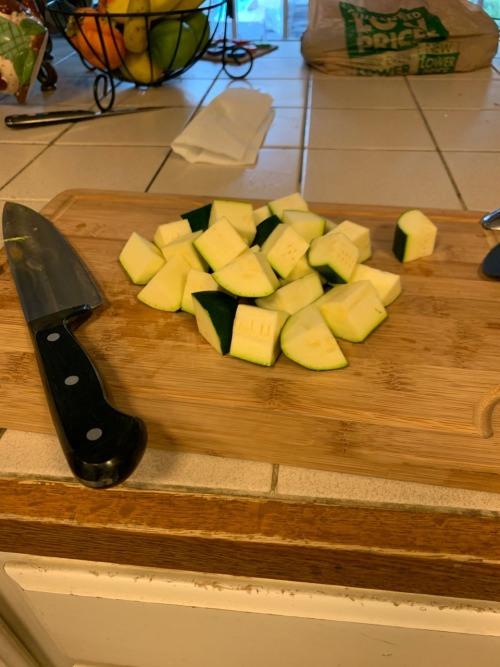
Put frying pan on medium heat with a little oil. Tubers or mushrooms or go in the pan a few minutes before the protein. 2 portions of the protein goes in the pan, about 5 minutes with lid (don't worry you can still get a good sear on both sides)
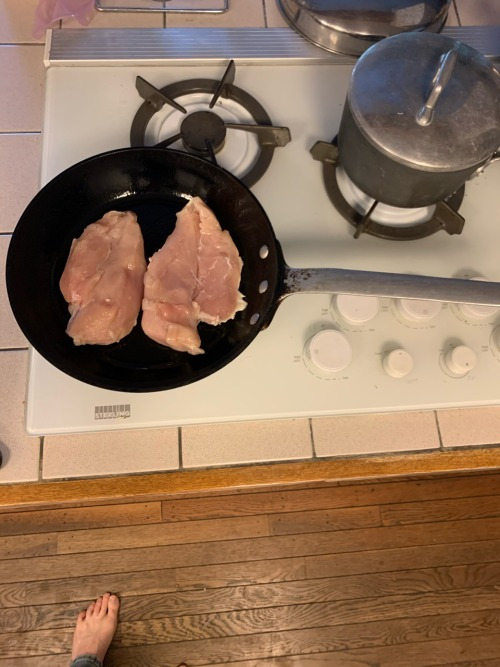

Now flip your protein if it's flip-able and add normal veggies, put the lid back on another five-ish minutes.
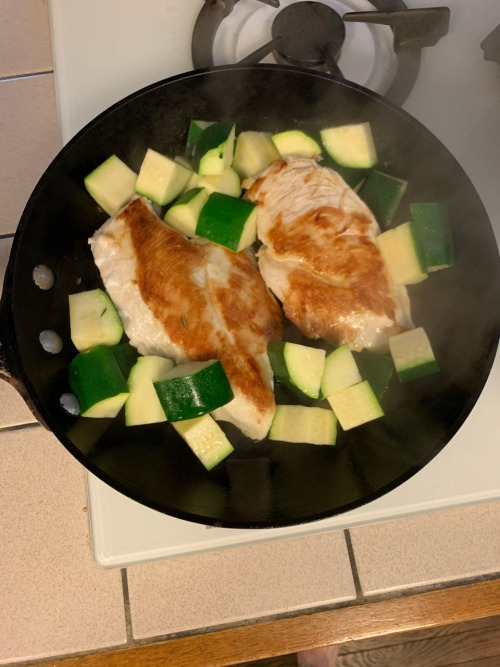
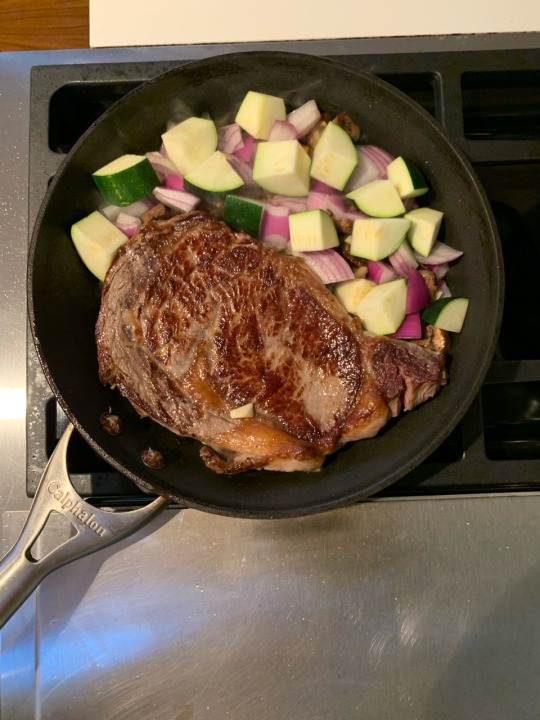
Take your protein out and put it with one portion of the veggies in a microwave safe container. That's going to be your lunch tomorrow. Put the other portion of protein on a plate to rest (you have to let a cooked protein sit a couple minutes before you serve it or when you cut into it all the juices run out and it goes dry - the liquids thicken as it cools, preventing this drying out if you let it rest, the goal is to serve it very warm but not hot hot)
While it's resting, pour some sauce from your bottle in the pan with the rest of the veggies and turn up the heat. A single sauce/bottle is fine, i like to get fancy and mix a couple. Two examples of personal favorite mixes are 1: bbq sauce and a hot sauce like sriracha 2: roughly equal parts low sodium soy sauce and worcestershire (makes something similar to a teriyaki sauce) A swallow of wine is almost always a great option if you want to add that to your sauce too, just add it to the pan before the other sauces so the alcohol has time to burn off.
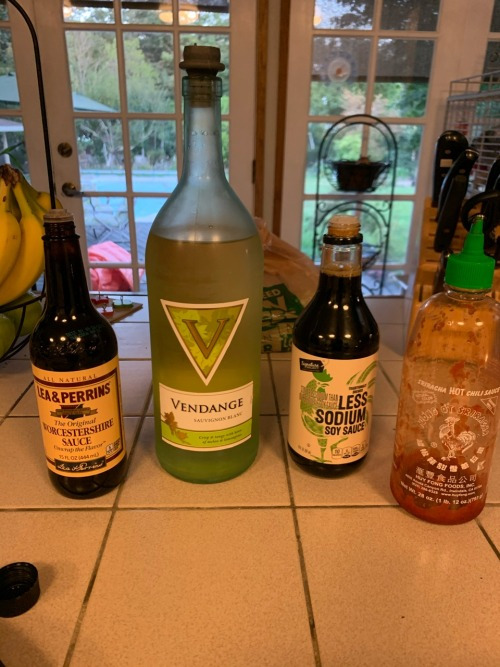
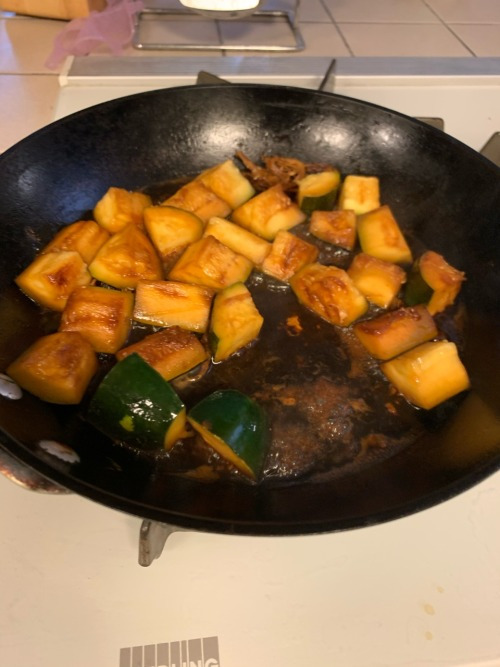
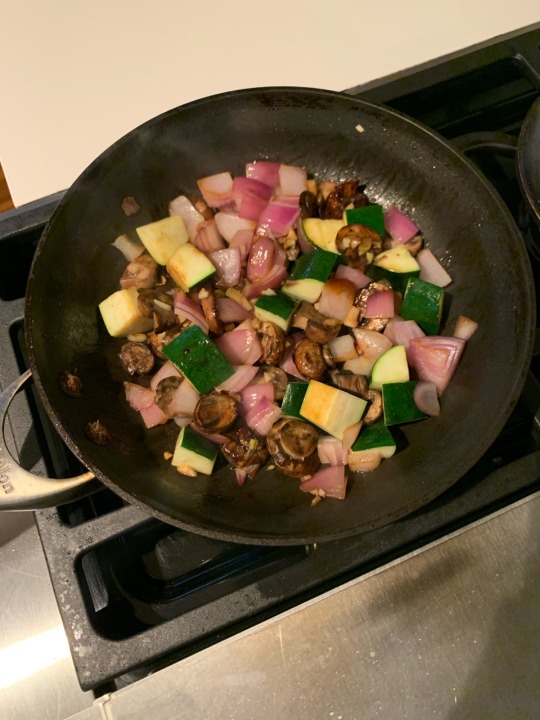
...
Here is the important bit. While your veggies are finishing, wash your cutting board and chef knife. Then when you dump your veggies and sauce over your protein on the plate, while it is still too hot to eat, you wash your frying pan and spatula before you eat. Now the only dishes you have left to do are your plate and fork. Maybe a steak knife.
...
The whole thing takes about 35 minutes even with washing the dishes, and that includes your lunch for the next day- just pour a different sauce on and stick it in the microwave for a couple minutes (or five minutes back in the frying pan) and you have a full healthy lunch with a different flavor
You can use this technique every single meal and it yields hundreds of combinations, from pork and potatoes bbq, to salmon and broccoli teriyaki, to chicken and zucchini in a soy glaze.
It will keep you down to less than an hour of kitchen time per day total for both lunch and dinner including all dish clean up, uses the least dishes, the least effort, requires the least technique, and is, depending on what you pick out, very affordable
here are a couple more examples from this month; i didn’t take pictures of the salmon i did recently, but you get the idea
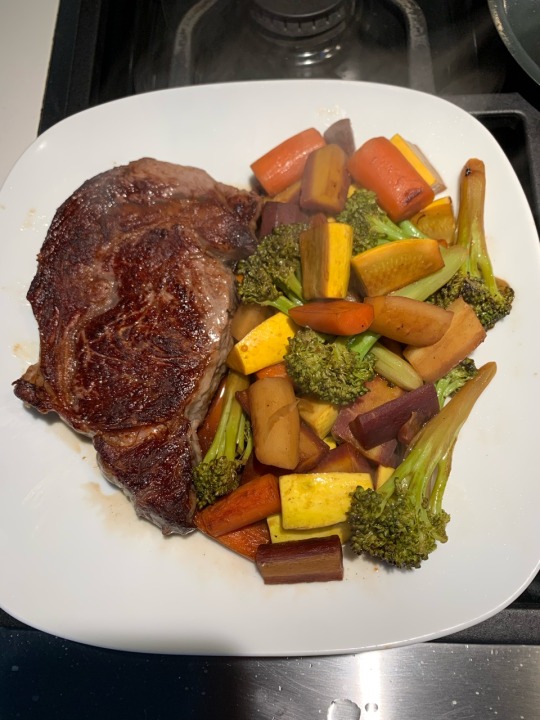
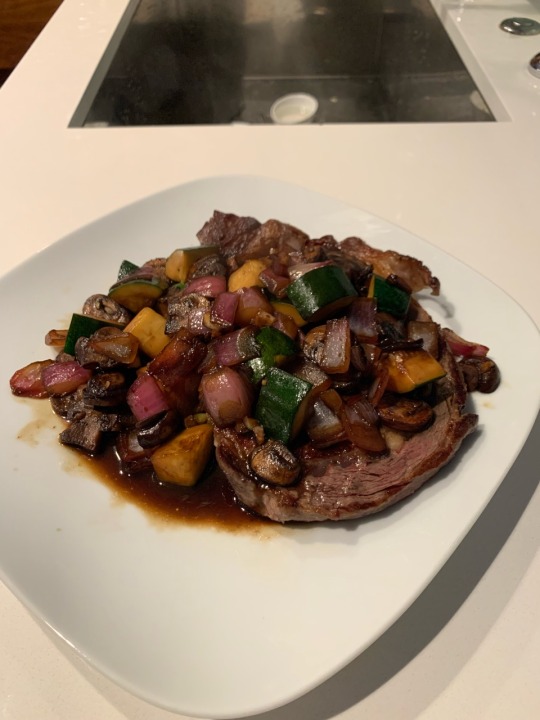
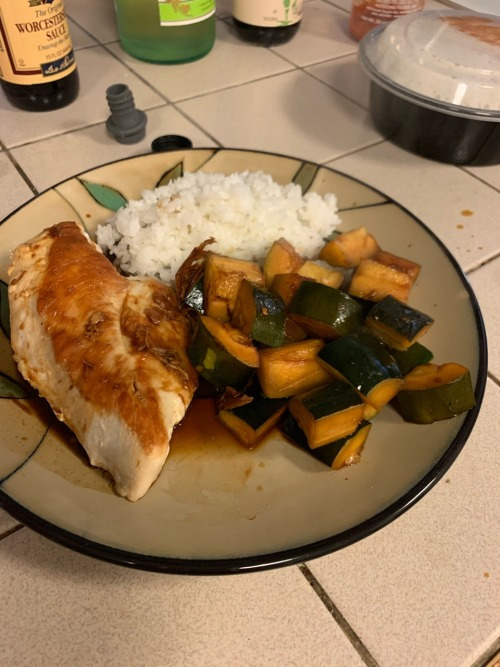
it's not super fancy, but it is easy, affordable, quick, and any flavors you want. Hope this helps some folks
Happy Cooking!
24K notes
·
View notes
Text
I thought I was more annoying about my job on here fjskdj I work in a small grocery store bakery/deli area. I make people's fried chicken or sliced meat/cheese or cold salads, mainly. Most of the bakery stuff is done by the time i get there, unless I have bag bread so im mostly doing deli stuff
#chicken strips fried chicken corndogs fried burritos various fried filled sticks jojos corn mac n cheese mashed potatos n gravy all that#plus any deli meat or cheese to slice up or cold salads to serve. keeping all that filled as it should and customers helped and refilling#cups n lids and bags and everything and sometimes making sandwiches and making sure we keep up on dishes and pulling empty donut trays and#bagging bread and/or making garlic bread and refilling pur strip buckets and refilling our little behind the counter stock of cups and lids#so we dont have to go into the creepy attic and Hunt for the stuff every time they run out#most of my work day is help customer or working to refill case how we need it to be#yeah. anyway i didnt work past 2 days cause i burnt my fingertips and the next 2 days are my scheduled days off so i get a mini vacation#from it#anyway!!! gn!!
0 notes
Text
you'll find my ass always trying to find excuses to sneak some kashmiri chili powder in everything sdhjfdshgvgsdvf
#eggs in any form? yes. potatoes in any form? yes. mac n cheese? you bet. stir fried veggies? hell yeah#any kind of noodles. any kind of pasta dish. fake meats. fake cheese.#everything. literally everything istg.
0 notes
Text
my advice to you; put a little dijon mustard in any cheesy beige food. whisk it into your cheese sauce just before u add the cooked macaroni. spread a thin layer in your cheese toasties. add a spoonful to your mashed potatoes with the butter. anything thats gonna be heavy on rich dairy and starches will benefit enormously from the hint of warmth and acidity that dijon mustard will give it, even if you don't add enough to make it Taste Like Mustard (which, ideally, you shouldnt). itll cut through the richness and stop your tastebuds getting fatigue from too much fat&starch, which is important for the overall enjoyment of a dish. ur welcome. take this knowledge and change the world
50K notes
·
View notes